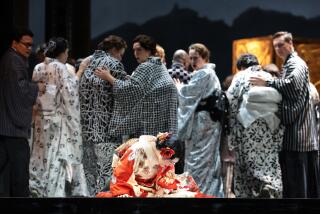STAGE REVIEWS : Japanese Theater--a Ritual in Real Discipline
- Share via
When we think of Japanese theater, we first think of the great ancestral forms--Kabuki, Noh, bunraku.
Discipline is their ground-note. When a Kabuki actor crosses his eyes in a mie (the Grand Kabuki will be back at the Japan America Theatre next week, by the way, starting Wednesday), we think of a baseball pitcher bearing down. Maximum force, maximum control.
What would Japanese avant-garde theater be like? Less formal? More personal? A little more personal, perhaps. There were some “private moments” in Shogo Ohta’s “The Water Station” at the JAT last weekend that would have raised eyebrows even in a Lee Strasberg class: bathroom moments, actually.
But the agonizing slowness with which each player approached the trickling spigot told us that we were involved in some kind of ritual here. That was also the signal of the strange scuttling movements of the kimono-clad actors in Tadashi Suzuki’s “The Tale of Lear” Tuesday night at the Berkeley Repertory Theatre.
But unlike the time-honored codes of Kabuki, these were new theater rituals, devised by the author-director of each piece. Both men have their own companies and training centers back in Japan, and both have found considerable fame on the international festival circuit.
“The Water Station” (“Mizu No Eki” in Japanese) was performed by Ohta’s company, Tenkei Gekijo (“The Theater of Transformation” in English). It took about two hours to perform, and the only sound was the slow plonk of the water from the central spigot, sometimes interrupted when an actor would drink from it.
It was startling how the silence would register as a sound, making a very Japanese point about the presence of absence. It was also sobering, somehow, to see a long line of people using a facility without a word, as if they had gone through an experience that made words trivial.
And it was interesting to see how many different uses these men and women could find for a water station--as a place to drink, to wash, to caress themselves, to make love, to fight, to scream.
After an hour of this, some people in the audience were doubtless ready to scream as well. Others were held by it. The individual actions were familiar, but so slowly performed that we were in a world of ceremony, a ceremony dimly standing for something else .
Some viewers may have thought of Dante’s Purgatory. Some might have thought of a nuclear holocaust. I thought, more abstractly, of the passage of the generations--each of us lining up to take our little moment of life, taking it, and joining the great majority.
“The Water Station” can take many another reading as well. As a theater piece, it could hardly be called lively, but it had its own stubborn, slow-moving pulse, and nobody could have enacted its water-seekers with more conviction than Ohta’s company--who, after all, helped invent them.
That wasn’t true of “The Story of Lear,” where Suzuki was working with American actors drawn from the four companies co-producing the event--Berkeley Rep, Milwaukee Rep, Arena Stage of Washington, D.C. and Stage West of Springfield, Mass.
The company did train with Suzuki in Japan. Where other directors think that theater starts with the voice, or the heart, Suzuki believes it starts with the foot, and this 90-minute condensation of “Lear” is stepped-out as well as acted.
The company (all-male) did resemble an ensemble, but a rather stone-faced one. If the idea is to keep the energy coiled up until it explodes, one didn’t see much real exploding Tuesday night, for all the declaiming and posturing.
The story is recognizably that of “King Lear,” played as the dream of an infirm old man (Tom Hewitt) tended by a slightly sadistic nurse (Jeffrey Bihr.) She doubles as the fool and wheels Lear onto the heath in a wooden laundry basket--a mirthless, debunking note.
Lit from the side and below (Arden Fingerhut did the lighting), the actors often reminded you of singers in an oratorio--not quite talking statues but more static than one was expecting from a director famed for his physicality. The pathos and terror of Suzuki’s “Trojan Women” at the Olympic Arts Festival were never reached, and were perhaps not looked for.
Suzuki had called the show an experiment. One conclusion may be that one can’t readily turn Western actors into Eastern ones. To do Suzuki, Kabuki has got to be in the background somewhere.
‘MIZU NO EKI (THE WATER STATION)’
Shogo Ohta’s theater piece, presented by his acting company, Tenkei Gekijo, at the Japan America Theatre. Director Ohta. With Tomoko Ando, Hirohisa Inoue, Hirofumi Sasajima, Makiko Takeuchi, Shoji Tsujigami, Tohru Shinagawa, Rieko Suzuki, Yuki Moriya, Nahomi Edamoto, Akemi Toi, Maki Ito, Tetsuya Segawa, Seiko Kitamura, Ryo Yoneda, Tokizo Tamura, Shunichi Imamura, Kimie Ushiyama, Kazuyo Sato, Ren Ohsugi, Takao Ono.
‘THE TALE OF LEAR’
Tadashi Suzuki’s version of Shakespeare’s “King Lear,” at the Berkeley Repertory Theatre. Director Suzuki. With Tom Hewitt, Laurence Ballard, Tom Blair, Corey Hansen, Charles Tuthill, Eric Hill, Matthew A. Loney, Larry G. Malvern, James DeVita, David Asher, Mark Corkins, Jeffrey Bihr. Scenic and lighting design Arden Fingerhut, based on a concept by Suzuki. Costumes Suzuki. Dramaturg Amlin Gray. Production stage manager Kimberly Mark Webb.
More to Read
The biggest entertainment stories
Get our big stories about Hollywood, film, television, music, arts, culture and more right in your inbox as soon as they publish.
You may occasionally receive promotional content from the Los Angeles Times.










